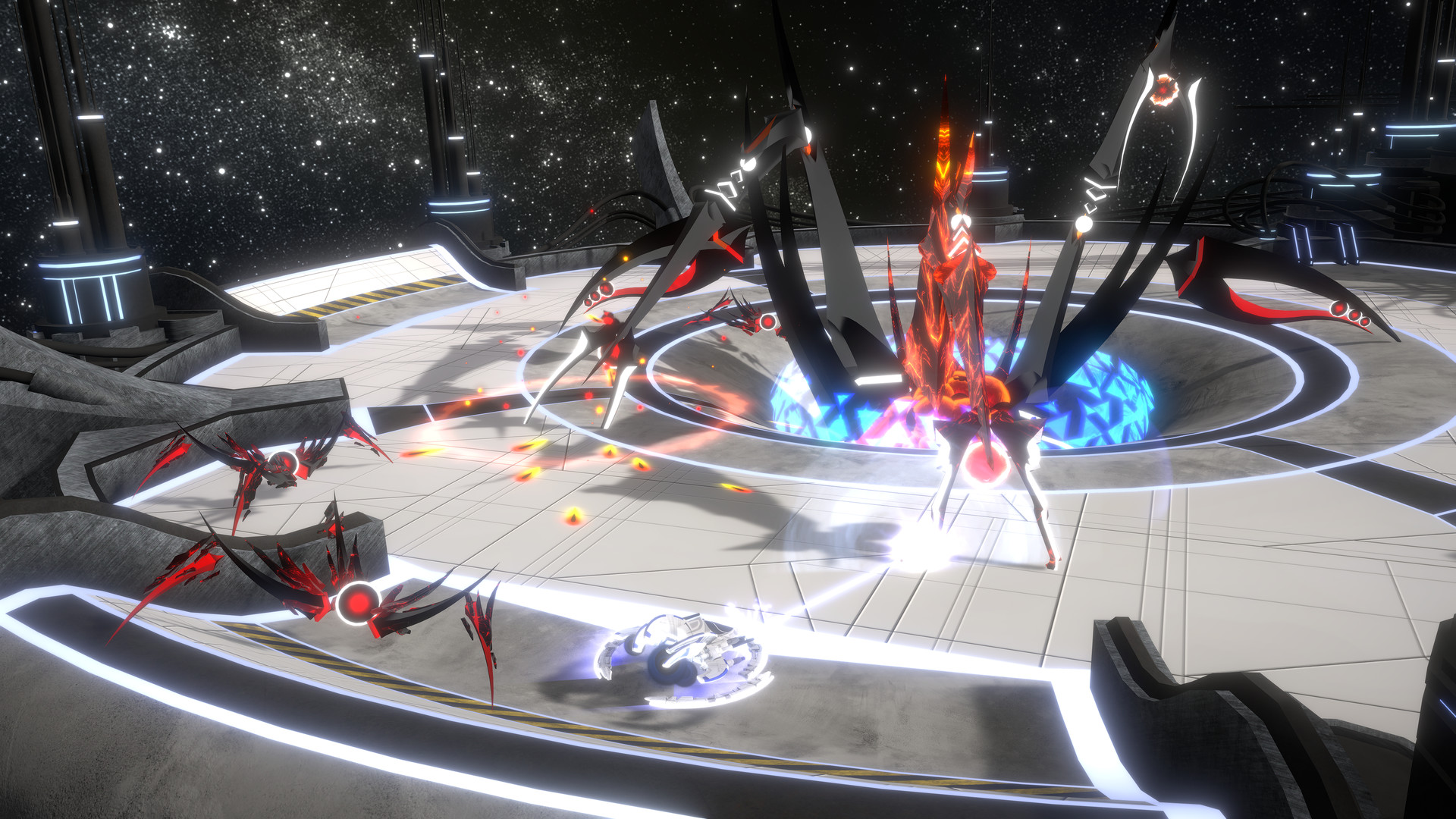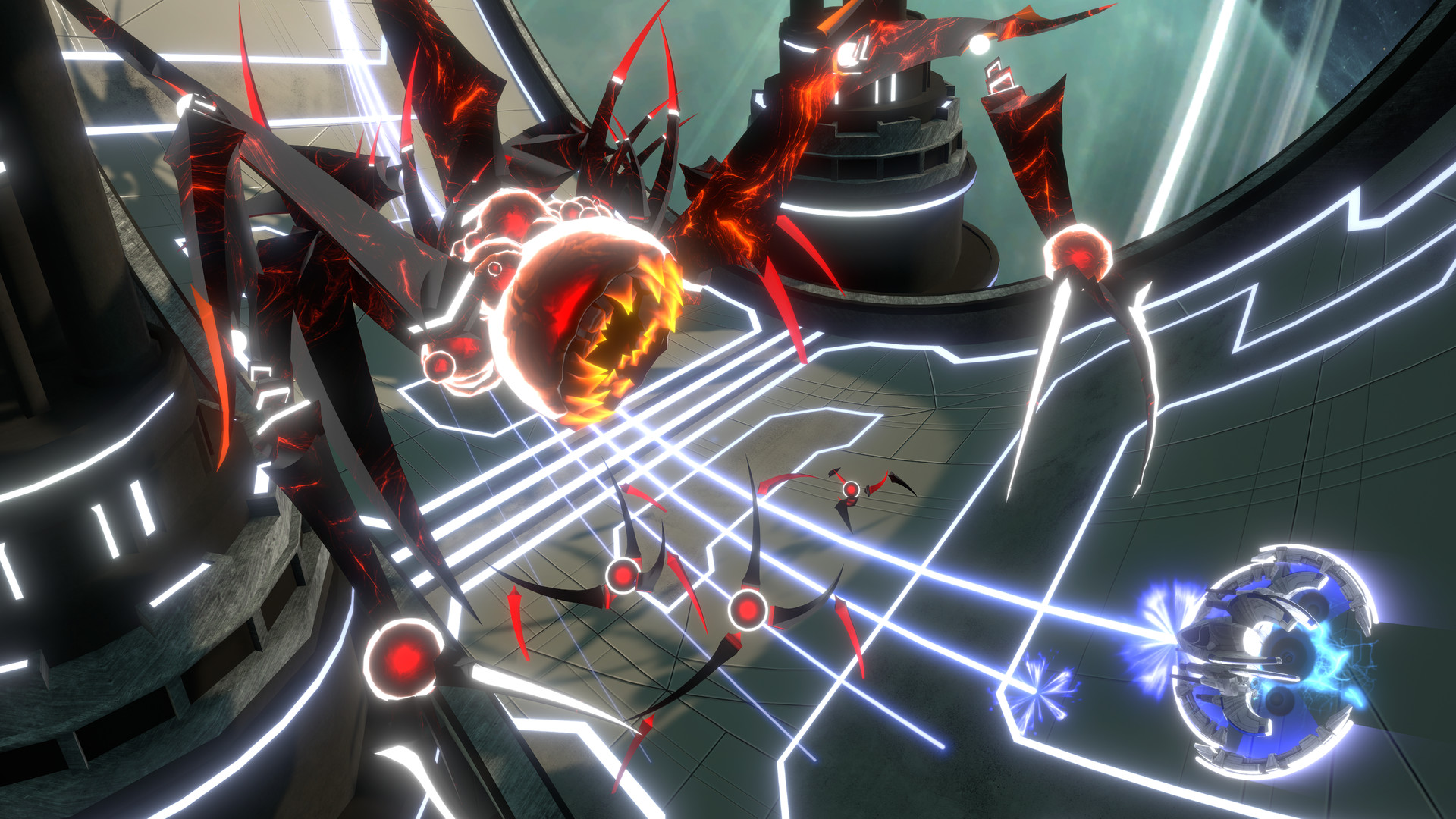This isn’t your regular twin-stick shooter. Only by Midnight’s upcoming Curved Space promises to deliver the fast, busy action you’d expect from a game of the genre, but it puts a twist on it- quite literally. It puts players in curved spaces, as the name suggests, and these winding and twisting zero-g levels add a whole another layer to shooting and aiming. Add to that roguelike mechanics and the promise of plenty of replay value, and you have a concept that sounds like a winner on paper. Curious as we are about the game, we recently reached out to the people behind it to learn more about what will make Curved Space tick, and learnt quite a bit in the process. You can read our conversation with Only by Midnight president and the game’s lead designer Andrew Czarnietzki below.
"The landscapes have a big impact on the moment-to-moment combat. There is technically no gravity as the game is effectively 2D—but if you imagine a 2D laser on a sheet of paper, that same laser will be bent and curved when the paper is folded in the third dimension. This gives a fun literal twist to aiming and a unique feel to enemies and weapons."
What was the inspiration behind the idea of making a twin stick shooter on these curved landscapes?
I was working on a lightmapping tool back in 2012 and spent a lot of time thinking about encoding interesting information directly onto surfaces. I’d also spent a lot of time playing fast paced action games like Steredenn and Unreal Tournament. Curved Space is basically an attempt to capture some of that action feel mapped directly onto a 3D surface. This gives a really interesting feel to the player, and allows some really interesting mechanics under the hood.
Will the nature of these landscapes have a mechanical impact on the gameplay? For instance, will players have to contend with things such as gravity?
The landscapes have a big impact on the moment-to-moment combat. There is technically no gravity as the game is effectively 2D—but if you imagine a 2D laser on a sheet of paper, that same laser will be bent and curved when the paper is folded in the third dimension. This gives a fun literal twist to aiming and a unique feel to enemies and weapons.
What can you tell us about the enemy design in Curved Space and how varied they will be?
Curved Space is all about enemies that are interesting to fight. They started with just a few variations of the “Energy Spider”, but we now have a range of mechanically distinct enemies including centipedes, rollies, and horrifying blobs. We also have some really interesting bosses! Each enemy has a distinct feel in how it moves, navigates, and engages the player.
Curved Space’s art style and its synthwave soundtrack look like really intriguing elements, and it seems they’re going to contribute significantly to the game’s aesthetic. What was the process like of building the game’s visual and audio identity, and how did you decide on what you ultimately went with?
The short answer is that the music I was listening to during development became the music in the game! The aesthetic is very much influenced by this music, which is why we have glowing lines and purple skies. We are absolutely thrilled to be working with FiXT Neon—they have some of our favorite music, and they really get games.
How much of a role will power-ups and unique weapons play in the combat? Can players expect a varied assortment to choose from?
Curved Space is all about shifting up that core combat loop, which means different weapons and abilities. One of my favorite outcomes design wise is that each weapon is a favorite for multiple people—but typically also someone’s least favorite. I also find that there’s a lot of fun when you have to use a weapon in a different way or get through a scenario with something other than your favorite. The upgrades and abilities have a pretty big impact as well, feeding the sense of progression and giving you more options to take on waves of spiders. This is especially exciting on higher difficulty levels with challenges turned on, where simply shooting is not enough to survive.
"Curved Space is all about enemies that are interesting to fight."
How deep will the upgrade mechanics be for these power-ups?
Some of the upgrades are story based, but most are presented in a randomized “rouge-lite” fashion. This keeps each run feeling a little different. The weapon drops and ammo drops are also tied into a fairly advanced system that drops based on time, usage, and difficulty. You should never feel without a weapon, but you should find yourself switching weapons often—or using higher level strategies to keep your weapons. You can also find some really interesting primary/secondary weapon pairings.
Curved Space is going to have several modes outside of the campaign, with arenas and survival and more, but do you have any plans for competitive multiplayer as well?
No multiplayer for this version. The short answer is that was just too much technical cost for this first release. Priority one if we ever do a sequel though!
Roughly how long will the game’s campaign be?
A single run is somewhere around 2 hours. This keeps individual sessions relatively short, but there are 6 different paths through the content, and we’d expect most players to try at least a few different runs to see how things unfold differently. The campaign also folds back into itself in an interesting way, so if you do have more than 2 hours you can keep going smoothly—with increasing difficulty.
Since the reveal of the PS5 and Xbox Series X’s specs, a lot of comparisons have been made between the clock speeds of the two consoles’ GPUs, with the PS5 at 10.28 TFLOPS and the Xbox Series X at 12 TFLOPS)- but how much of an impact on development do you think that difference will have?
We’ve spent a lot of time getting Curved Space optimized to run on lower end PCs and the Tegra chipset at the heart of the Nintendo Switch. The good news about this is that for either next gen console we can smoothly handle 4k and 120 fps with every graphic setting I have cranked to the max!
The PS5 features an incredibly fast SSD with 5.5GB/s raw bandwidth. How can developers take advantage of this? How does this compare to Series X’s 2.4GB/s raw bandwidth?
From my perspective, loading times are fast. Now, our load times weren’t too long before, so this is just a nice bump but doesn’t really change things too much. I am excited for some really interesting tech, such as that crazy Unreal 5 Nanite demo.
There is a difference in the Zen 2 CPUs of the two consoles. The Xbox series X features 8x Zen 2 Cores at 3.8GHz, whereas the PS5 features 8x Zen 2 Cores at 3.5GHz. Your thoughts on this difference?
Both blow my dev computer out of the water and handle everything I can throw at them. My dev philosophy is more about giving the best experience to the most players, so if 0.2 GHZ made a transformative difference for one set that likely means other users are hurting. I will say that the differences between the consoles performance wise feels a lot less than say the differences between the PS4 and Xbox One.
"Some of the upgrades are story based, but most are presented in a randomized “rouge-lite” fashion. This keeps each run feeling a little different. The weapon drops and ammo drops are also tied into a fairly advanced system that drops based on time, usage, and difficulty."
The Xbox Series S features lesser hardware compared to Xbox Series and Microsoft is pushing it as a 1440p/60fps console. Do you think it will be hold up for the graphically intensive next-gen games?
I think it depends on the game and what exactly the devs are doing. Curved Space is lean and all about that ultra-smooth performance. We also aren’t pushing this tech to the limit. I’m personally really excited to see more raytracing like it was done in Control, but what that looks like long term I’m not quite sure yet.
What resolution and fps is the game targeting to run on PS5, Xbox Series X and Xbox Series S? Furthermore, will the game have multiple graphical modes?
PS5 and Xbox Series X: 4k/120 fps, buttery smooth. Xbox Series S: 1440p/60 fps, and still buttery smooth. PS4 and Xbox One: 108op/60 fps.
We have two major graphic modes, which basically comes down to how much we are leveraging the GPU for our force-field-based physics and energy particles. This lets us also have an action-based game on Nintendo Switch, while scaling up the detail for PS5 and Xbox Series X. This also applies to PC: you’re going to have a great experience on anything from a moderate computer getting pretty long in the tooth to the most cutting-edge build.




Comments
Post a Comment